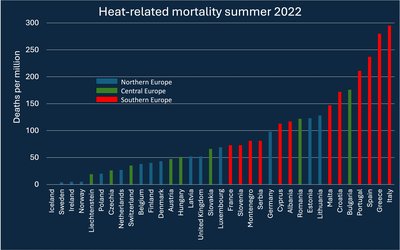
The increase in the number of extreme temperature events is illustrated by heat waves in Europe in 2003, 2007 and 2010, with the 2010 event surpassing the 2003 heat wave in terms of temperature and spatial extent. Temperatures in 2010 broke twentieth and twenty-first century records, with an 80% probability the record heat would not have occurred without climate change.
The number of deaths due to cold and hot extreme temperatures attributable to climate change was estimated for Stockholm by comparing data on temperature and mortality for 1900-1929 and 1980-2009. Cold extremes were defined such that they correspond with temperatures below – 6.3°C; heat corresponds to temperatures above 19.6°C. Results adjusted for urbanization and heat island effects show that there was a small increase in extreme cold temperature-related mortality and a substantial increase in extreme heat temperature-related mortality in 1980-2009 as compared with 1900-1929. Not adjusting for urbanization and heat island effects, there was a small decrease in extreme cold temperature mortality in 1980-2009 compared with 1900-1929, with a much larger increase in extreme hot temperature mortality.
Future changes in the frequency and intensity of heat waves might be of a magnitude large enough to overwhelm the ability of individuals and communities to adapt. The expected increase in the number of elderly and other potentially vulnerable groups, in absolute numbers and as a proportion of the population, could make the impact of temperature extremes on human health even more severe.
Source: Oudin Åström et al., 2013. Nature Climate Change 3, December 2013: 1050-1054.
Photo: Edward Stojakovic (www.flickr.com)








